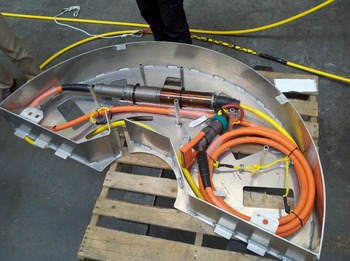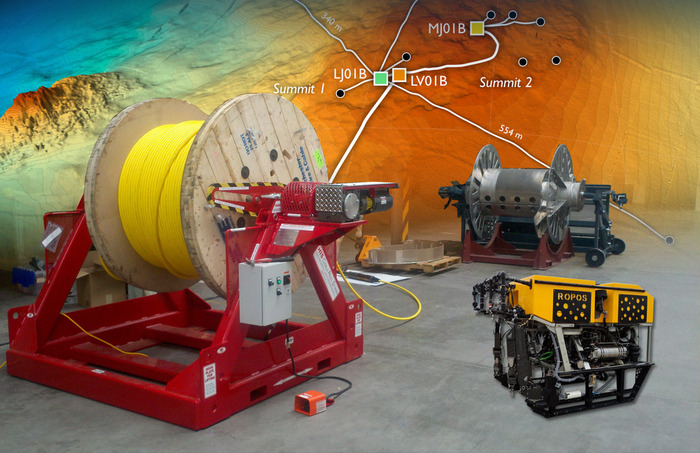
The first step in the cable loading process is to pack the flange box used by ROPOS for seafloor deployment. The flange box protects the components and makes them easier for the ROV to handle on the seafloor. Components are the 400- to 4700-meter long secondary cable (yellow), cable termination (cylindrical titanium case near the top), oil-filled hose (orange), and the ROV wet-mateable connector (with orange handle and green ring next to coiled hose) that will plug into a receptacle on the primary or secondary node.
Engineers for the Regional Scale Nodes (RSN) component of the National Science Foundation's Ocean Observatories Initiative (OOI) are busy preparing cables for installation on the network this coming summer.
Before you can install a secondary cable for the regional cabled observatory, you’ve got to get that cable safely and efficiently to the seafloor. And before you get it to the seafloor, you’ve got to load it onto a drum that fits the robotic vehicle that will be doing the installation. Right now, as preparations are at full tilt for this summer’s installation of much of the secondary infrastructure, RSN engineers are working at the Sand Point Facility to carefully transfer the custom-designed secondary cables from the manufacturer’s delivery reels to a special drum for the Remotely Operated Cable Laying System (ROCLS) that fits onto ROPOS. ROPOS is an underwater robot, the remotely operated vehicle (ROV) that will be the workhorse of the OOI cabled observatory’s secondary infrastructure installation this summer.
This summer’s work follows RSN primary cable installation in 2011 and primary node installation in 2012. Both of these primary infrastructure installations required telecommunications industry vessels; the RSN secondary infrastructure is designed to be installed using an academic-class research vessel and remotely operated vehicle (ROV). Using the R/V Thompson and ROV ROPOS, the goal for summer 2013 is to install much of the secondary instrastructure: three types of secondary nodes, three types of secondary cables, and a number of instruments. Cables laid this summer will connect primary nodes to secondary nodes and daisy-chained secondary nodes to each other. Profiling moorings are scheduled for installation in 2014.
According to Tim McGinnis, Principal Engineer, who is overseeing the cable design, assembly, and loading operations, the three different kinds of secondary cables used on the RSN system are the following: high-power electro-optical cable that will connect to the low-voltage nodes at the base of the moored profilers; medium-power electro-optical cable, which McGinnis calls “the workhorse” cable because it goes to a variety of different secondary nodes and to the HD video camera; and an electrical cable used for long runs (400 to 1200 meters) out to seismometers and other remote instruments. Each type of cable must be terminated and fitted with a connector that the ROV manipulates to connect the cable to the secondary node for power and data communication. And it all must suvive the trip to the seafloor, the corrosiveness of seawater, laying the cable on the seafloor, and pressures of up to 4000 pounds per square inch.
Terminating and spooling the cables are a team effort. Technicians from Teledyne ODI, a company that specializes in underwater connectors, are working at Sand Point to terminate the cables with a field assembled cable termination, or FACT. On the other side of the FACT is a 7-meter section of oil-filled hose, used for flexibility and pressure balancing, that is, in turn, connected to the ROV mateable connector.
Members of the ROV ROPOS team have been on site to assist and train RSN engineers in the art and technique of spooling cable onto the ROCLS drum. Among the precision procedures developed by the ROPOS team is the securing of the termination, oil filled hose, and ROV mateable connector in a specially designed flange box. This design protects and keeps untangled the cable, terminations, and hose during deployment.
Components in the spooling process are shown in the accompanying photos provided by Tim McGinnis.



